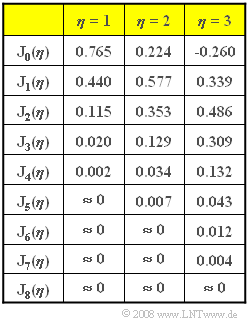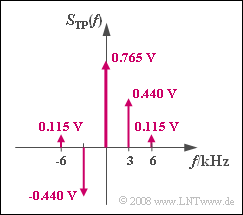Difference between revisions of "Aufgaben:Exercise 3.2: Spectrum with Angle Modulation"
m |
m (→Questions) |
||
| Line 32: | Line 32: | ||
<quiz display=simple> | <quiz display=simple> | ||
| − | { | + | {Which modulation method is used here? |
|type="()"} | |type="()"} | ||
| − | - | + | - Amplitude modulation. |
| − | + | + | + Phase modulation. |
| − | - | + | - Frequency modulation. |
| − | { | + | {Which modulation method would you choose if the channel bandwidth was only $B_{\rm K} = 10 \ \rm kHz$ ? |
|type="()"} | |type="()"} | ||
| − | + | + | + Amplitude modulation. |
| − | - | + | - Phase modulation. |
| − | - | + | - Frequency modulation. |
| − | { | + | {How should one choose the modulator constant $K_{\rm M}$ for a phase deviation of $η = 1$ ? |
|type="{}"} | |type="{}"} | ||
$K_{\rm M} \ = \ $ { 0.5 3% } $\ \rm 1/V$ | $K_{\rm M} \ = \ $ { 0.5 3% } $\ \rm 1/V$ | ||
| − | { | + | {Calculate the spectrum $S_{\rm TP}(f)$ of the equivalent low-pass signal $s_{\rm TP}(t)$. |
| − | + | What are the weights of the spectral lines at $f = 0$ and $f = -3 \ \rm kHz$? | |
|type="{}"} | |type="{}"} | ||
$S_{\rm TP}(f = 0)\ = \ $ { 0.765 3% } $\ \rm V$ | $S_{\rm TP}(f = 0)\ = \ $ { 0.765 3% } $\ \rm V$ | ||
$S_{\rm TP}(f = -3\ \rm kHz) \ = \ $ { -0.453--0.427 } $\ \rm V$ | $S_{\rm TP}(f = -3\ \rm kHz) \ = \ $ { -0.453--0.427 } $\ \rm V$ | ||
| − | { | + | {Calculate the spectra of the analytical signal $s_{\rm +}(t)$ and the physical signal $s(t)$. What are the weights of the spectral lines at $f = 97 \ \rm kHz$? |
|type="{}"} | |type="{}"} | ||
$S_+(f = 97 \ \rm kHz)\ = \ $ { -0.453--0.427 } $\ \rm V$ | $S_+(f = 97 \ \rm kHz)\ = \ $ { -0.453--0.427 } $\ \rm V$ | ||
| Line 60: | Line 60: | ||
| − | { | + | {What is the required channel bandwidth $B_{\rm K}$ for $ η = 1$, if one ignores pulse weights smaller (in magnitude) than $0.01$ ? |
|type="{}"} | |type="{}"} | ||
$η = 1\text{:} \ \ \ B_{\rm K}\ = \ $ { 18 3% } $\ \rm kHz$ | $η = 1\text{:} \ \ \ B_{\rm K}\ = \ $ { 18 3% } $\ \rm kHz$ | ||
| − | { | + | {What would be the channel bandwidths for $η = 2$ and $η = 3$ ? |
|type="{}"} | |type="{}"} | ||
$η = 2\text{:} \ \ \ B_{\rm K}\ = \ $ { 24 3% } $\ \rm kHz$ | $η = 2\text{:} \ \ \ B_{\rm K}\ = \ $ { 24 3% } $\ \rm kHz$ | ||
| Line 70: | Line 70: | ||
</quiz> | </quiz> | ||
| − | |||
===Musterlösung=== | ===Musterlösung=== | ||
Revision as of 14:40, 14 March 2022
The following equations are assumed here:
- Source signal:
- $$q(t) = 2\,{\rm V} \cdot \sin(2 \pi \cdot 3\,{\rm kHz} \cdot t)\hspace{0.05cm},$$
- Transmit signal:
- $$s(t) = 1\,{\rm V} \cdot \cos\hspace{-0.1cm}\big[2 \pi \cdot 100\,{\rm kHz} \cdot t + K_{\rm M} \cdot q(t)\big ]\hspace{0.05cm},$$
- Received signal (ideal channel):
- $$r(t) = s(t) = 1\,{\rm V} \cdot \cos\hspace{-0.1cm}\big[2 \pi \cdot 100\,{\rm kHz} \cdot t + \phi(t)\big ]\hspace{0.05cm},$$
- ideal demodulator:
- $$ v(t) = \frac{1}{ K_{\rm M}} \cdot \phi(t)\hspace{0.05cm}.$$
The graphs shows the $n$–th order Bessel functions of the first kind ${\rm J}_n (\eta)$ in table form.
Hints:
- This exercise belongs to the chapter Phase Modulation.
- Particular reference is made to the pages Spectral function of a phase-modulated sine signal and Interpretation of the Bessel spectrum.
Questions
Musterlösung
(2) Eine Winkelmodulation (PM, FM) führt bei bandbegrenztem Kanal stets zu nichtlinearen Verzerrungen.
- Bei Zweiseitenband-Amplitudenmodulation (ZSB-AM) ist hier dagegen bereits mit $B_{\rm K} = 6 \ \rm kHz$ eine verzerrungsfreie Übertragung möglich ⇒ Antwort 1.
(3) Der Modulationsindex (oder Phasenhub) ist bei Phasenmodulation gleich $η = K_{\rm M} · A_{\rm N}$.
- Somit ist die Modulatorkonstante $K_{\rm M} = 1/A_{\rm N}\hspace{0.15cm}\underline { = 0.5 \rm \cdot {1}/{V}}$ zu wählen, damit sich $η = 1$ ergibt.
(4) Es liegt ein sogenanntes Besselspektrum vor:
- $$ S_{\rm TP}(f) = A_{\rm T} \cdot \sum_{n = - \infty}^{+\infty}{\rm J}_n (\eta) \cdot \delta (f - n \cdot f_{\rm N})\hspace{0.05cm}.$$
- Dieses ist ein diskretes Spektrum mit Anteilen bei $f = n · f_{\rm N}$, wobei $n$ ganzzahlig ist.
- Die Gewichte der Diracfunktionen sind durch die Besselfunktionen gegeben. Mit $A_{\rm T} = 1\ \rm V$ erhält man:
- $$ S_{\rm TP}(f = 0) = A_{\rm T} \cdot {\rm J}_0 (\eta = 1) \hspace{0.15cm}\underline {= 0.765\,{\rm V}},$$
- $$ S_{\rm TP}(f = f_{\rm N}) = A_{\rm T} \cdot {\rm J}_1 (\eta = 1)\hspace{0.15cm} = 0.440\,{\rm V},$$
- $$ S_{\rm TP}(f = 2 \cdot f_{\rm N}) = A_{\rm T} \cdot {\rm J}_2 (\eta = 1) = 0.115\,{\rm V} \hspace{0.05cm}.$$
- Aufgrund der Symmetrie ${\rm J}_{-n} (\eta) = (-1)^n \cdot {\rm J}_{n} (\eta)$ erhält man für die Spektrallinie bei $f = -3 \ \rm kHz$:
- $$S_{\rm TP}(f = -f_{\rm N}) = -S_{\rm TP}(f = +f_{\rm N}) =\hspace{-0.01cm}\underline { -0.440\,{\rm V} \hspace{0.05cm}}.$$
Anmerkung: Eigentlich müsste man für den Spektralwert bei $f = 0$ schreiben:
- $$S_{\rm TP}(f = 0) = 0.765\,{\rm V} \cdot \delta (f) \hspace{0.05cm}.$$
- Dieser ist somit aufgrund der Diracfunktion unendlich groß, lediglich das Gewicht der Diracfunktion ist endlich.
- Gleiches gilt für alle diskreten Spektrallinien.
(5) $S_+(f)$ ergibt sich aus $S_{\rm TP}(f)$ durch Verschiebung um $f_{\rm T}$ nach rechts. Deshalb ist
- $$S_{\rm +}(f = 97\,{\rm kHz}) = S_{\rm TP}(f = -3\,{\rm kHz}) \hspace{0.15cm}\underline {=-0.440\,{\rm V}} \hspace{0.05cm}.$$
- Das tatsächliche Spektrum unterscheidet sich von $S_+(f)$ bei positiven Frequenzen um den Faktor $1/2$:
- $$S(f = 97\,{\rm kHz}) = {1}/{2} \cdot S_{\rm +}(f = 97\,{\rm kHz}) \hspace{0.15cm}\underline {=-0.220\,{\rm V}} \hspace{0.05cm}.$$
- Allgemein kann geschrieben werden:
- $$ S(f) = \frac{A_{\rm T}}{2} \cdot \sum_{n = - \infty}^{+\infty}{\rm J}_n (\eta) \cdot \delta (f \pm (f_{\rm T}+ n \cdot f_{\rm N}))\hspace{0.05cm}.$$
(6) Unter der vorgeschlagenen Vernachlässigung können alle Bessellinien ${\rm J}_{|n|>3}$ außer Acht gelassen werden.
- Damit erhält man $B_{\rm K} = 2 · 3 · f_{\rm N}\hspace{0.15cm}\underline { = 18 \ \rm kHz}$.
(7) Die Zahlenwerte in der Tabelle auf der Angabenseite zeigen, dass nun folgende Kanalbandbreiten erforderlich wären:
- für $η = 2$: $B_{\rm K} \hspace{0.15cm}\underline { = 24 \ \rm kHz}$,
- für $η = 3$: $B_{\rm K} \hspace{0.15cm}\underline { = 36 \ \rm kHz}$.

